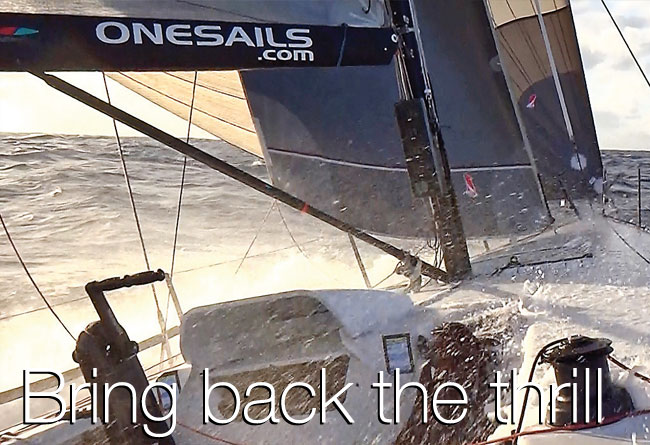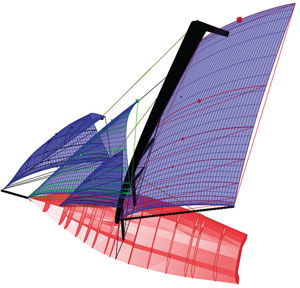

Power-reaching has always been a highlight of offshore racing but more sailors are now also looking beyond those up and down inshore courses
There is nothing more exhilarating in offshore sailing than powerreaching – the point of sail we dream about that makes the other legs of a tough race worth the pain… High speeds, spray and that visceral thrill we get knowing a boat is being pushed to its limits as the miles are speedily devoured.
A drawback on this point of sail, however, is the heeling and imbalance that can happen when there’s either too much force on the sailplan from the masthead Code 0 (MH0) or even the fractional Code 0 (FR0), resulting in costly sometimes brutal course deviations to hold on to these sails. Yet the speed and power are hard to give up, even with the extra miles covered – while constantly recalculating the VMG trade-offs against a lower heading.
Often the only way to stay high enough to stay on course is to reduce the power and heeling moment by dousing the larger sails and shifting down to smaller headsails. But then there is a significant loss of power and speed, with more of the mainsail needed to maintain drive force. Using more main means shifting the load balance aft, which in turn results in more helm pressure to stay on track. The more main used, the more weather helm needed, and the greater the rudder angle which creates drag, inhibiting speed further.
The result is often a ‘void’ for the otherwise well-equipped offshore racer where the sail inventory is simply not optimised to get the best speed at the desired angle. The latest-generation ocean greyhounds chasing course records know this and have been designed with their masts well aft, creating enormous foretriangles in which to fly multiple combinations of headsails and staysails, often mounted on furlers for easy deployment.

It’s easy to achieve a big foretriangle on a new build – you simply move the mast aft and adjust appendages accordingly. For existing boats it’s less easy, hence the approach by OneSails that involves creating new headsails specifically designed to be flown as far foward as possible off the sprit. The ‘gap’ is then filled with other sail types chosen according to the boat and its racing programme. Note in the simulation how the sail designer has resisted the temptation to be greedy with the area in the forward headsail, opting for more even flow across all three sails
Not all of us have the luxury of reconfiguring the entire boat – mast position, sailplan and appendages – just to accommodate a larger foretriangle and remain competitive in other sailing modes. But we can find speed in reducing heel while retaining power in the sailplan. OneSails has been working hard on this problem. Paul Eldrid of
OneSails in Perth is gearing up for the Austral summer season, and examining how to power up a variety of fast designs ranging from a Bakewell-White 36 to a HH42, DK 46, Carkeek 47 and several TP52s. All show benefits from new reaching headsail designs from OneSails.
When given the space to operate efficiently, flying multiple headsails will not only provide more power to better balance out a fully trimmed mainsail, and reduce drag from the rudder, it will also stabilise the flow across the whole sailplan.
‘Fortunately there are no restrictions in IRC and very generous headsail allowances in ORCi that allow for development of these sails to fit an important niche for the passage racer,’ says Eldrid. ‘We have made several discoveries in this process that we think will really re-energise these boats in reaching conditions.’
Rather than the traditional arrangement of tacking a reaching headsail at the bow and then trying to fit in a genoa staysail somewhere on the foredeck, Eldrid has been experimenting with putting the larger headsail out on the end of the bowsprit (called the J0), giving plenty of room to fit another headsail aft of this, such as the new square-top jib staysail (the JS).
Many of us are used to course racing, where headsails all carry battens… this is not necessary with these reaching sails since the depth is further aft and leeches do not need to be straight, in fact they should twist for optimal flow. With no battens, furlers then become a strong option for more boats.
Optimal combinations of the headsails, reaching spinnakers and a reefed or full-hoist main are many and varied. Mindful of cost, OneSails is now developing ‘turbo-charged multiple headsail solutions’ that still use the niches of the MH0 and FR0 but now supplement them with new sails including the J0 and JS.
Up until now OneSails has been building these sails in panelled construction as they test mould shapes at full scale. However, the company’s design and R&D teams are also conducting a fuller Fluid Structure Interaction (FSI) study to provide the data to start using its continuous yarns one-piece 4T FORTE composite membranes to optimise for strength and weight.
‘Already we’re seeing a strong interest in bringing back the fun and thrill of more efficient reaching on all courses,’ says Eldrid. ‘This is an exciting new development path.’
Click here for more information on OneSails »
We invite you to read on and find out for yourself why Seahorse is the most highly-rated source in the world for anyone who is serious about their racing.
To read on simply SIGN up NOW
Take advantage of our very best subscription offer or order a single copy of this issue of Seahorse.
Online at:
www.seahorse.co.uk/shop and use the code TECH20
Or for iPad simply download the Seahorse App at the iTunes store


